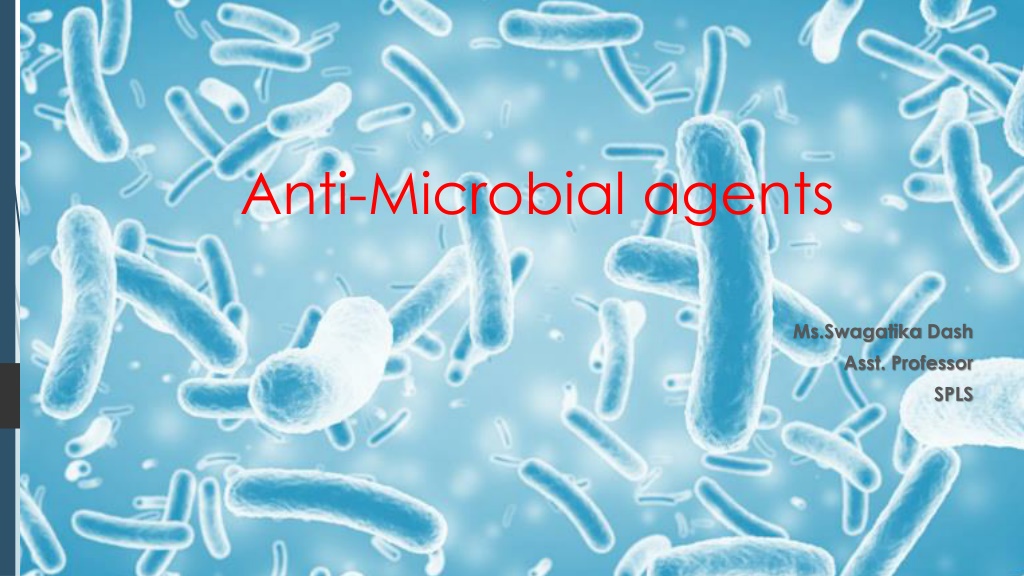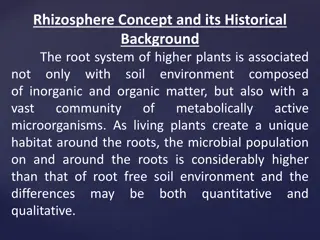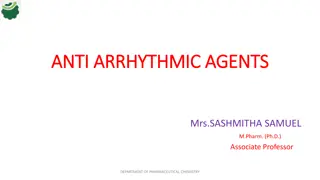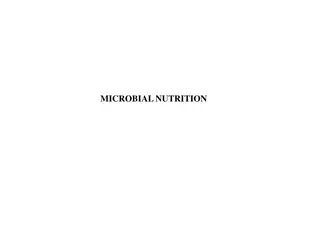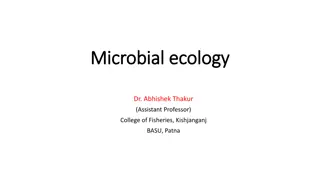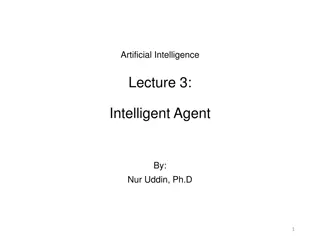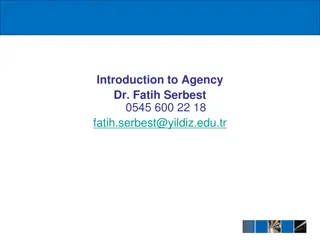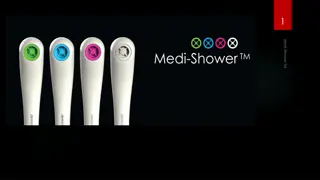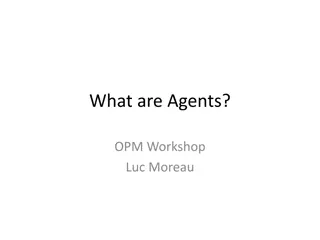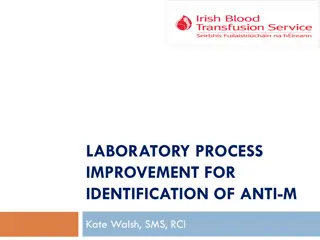Understanding Anti-Microbial Agents and Their Applications
Anti-microbial agents, including antiseptics, disinfectants, and germicides, play a crucial role in preventing infections and promoting public health. They can inhibit the growth of pathogenic micro-organisms on living tissues, objects, and materials. Sterilization ensures complete destruction of all living organisms. Bacteriostatic agents hinder microbial growth without killing them. Sanitizers maintain general public health standards through cleaning and washing away organic matter.
Uploaded on Nov 14, 2024 | 0 Views
Download Presentation

Please find below an Image/Link to download the presentation.
The content on the website is provided AS IS for your information and personal use only. It may not be sold, licensed, or shared on other websites without obtaining consent from the author. Download presentation by click this link. If you encounter any issues during the download, it is possible that the publisher has removed the file from their server.
E N D
Presentation Transcript
Anti-Microbial agents Ms.Swagatika Dash Asst. Professor SPLS
Definition The chemicals and their preparations used to destroy or inhibit the growth of pathogenic micro-organisms are called anti-microbial agents.
Antiseptics The substances that are able to kill or prevent the growth of micro- organisms on the living tissues are called antiseptics. Antiseptic agents oppose the sepsis, putrefaction or decay of the damaged or exposed tissue by inhibiting microbial multiplication and metabolic activities or by killing the pathogenic micro-organisms. They can be applied to almost all tissues of the body and may be used in the form of mouth wash, soaps, deodorants, throat and nasal sprays and vaginal douches.
Disinfectants The substances that prevent infection by the destruction of pathogenic micro-organisms are called disinfectants. These are applied to inanimate (non-living) objects and materials (instruments, equipment, rooms etc.) Disinfectants play a major role in public health sanitation and in water treatment.
Sterilisation The term sterile is used for a product or material object totally free from any and all forms of living organisms The complete destruction of all living micro-organisms, including bacterial spores is called sterilisation. It can be achieved by physical methods (application of heat or radiation) or by chemical methods (use of chemical disinfectants).
Germicide Germicide is a broad term (germs= microorganisms, cide= to kill) used to include different agents employed to kill various kinds of microorganisms. Different specific terminology are used like bactericide (against bacteria), fungicide (against fungi), virucide (against virus).
Bacteriostatic The agents which do not kill micro-organisms or bacteria but inhibit the growth are described by the terms using suffix static .
Sanitizers Disinfectants that are used to maintain general public health standards, are termed as sanitizers. Sanitation is mainly concerned with cleaning or washing away the organic matter (saliva, mucous etc.)
Classification of anti-microbial agents Oxidative antimicrobial agents- e.g Hydrogen peroxide solution, Zinc peroxide, Sodium perborate, Potassium permanganate, Sodium hypochlorite solution, Chlorinated lime. Iodine preparations and compounds- Iodine and iodine solutions, povidone- iodine Protein precipitant antimicrobial agents- silver nitrate, mild silver protein Mercury compounds- Yellow mercuric oxide, ammoniated mercury, mercuric chloride Sulphur and sulphur compounds- Sublimed sulphur, precipitated sulphur, sulphur dioxide, sulphurated potash, selenium sulphide, cadmium sulphide Boric acid and borax- sodium borate Arsenic compounds- carbarsone, glycobiarsol, tryparsamide Antimony compounds- antimony sodium gluconate, stibophen
Characteristics of anti-microbial agents It should possess antiseptic or germicide activity and not bacteriostatic activity. It should have rapid onset and sustained activity. It must possess good therapeutic index indicating usefulness in the concentration employed. It should not cause local cellular damage or should not interfere with body defence. It should show no systemic toxicity from topical applications. It should have in general broad spectrum of activity against bacteria, fungi, protozoa, virus etc. The topical antimicrobial agents should have favourable lipid water distribution coefficient so that its effectiveness has been best.
Mechanism of anti-microbial agents The mechanism of action of antimicrobial agents may range from a mild astringent to powerful oxidative processes. Inorganic compounds are generally not used as anti-infective for systemic infections, as they are not administered internally like antibiotics or sulphonamides, except in a very few cases for topical applications (dermatological, oral, ear, ophthalmic etc.) they may be used with caution. Inorganic compounds generally exhibit antimicrobial action by involving either of the following three mechanism i.e. (1) Oxidation (2) Halogenations (3) Protein binding or precipitation (4) Astringents
Oxidation mechanism Compounds acting by this mechanism belong to class of peroxides or peroxyacids, oxygen liberating like permanganate and certain oxo-halogen anions. These anti-infective agents bring about oxidation of active functional groups or reducing groupsnpresent in the proteins or enzymes vital to the growth or survival of micro-organisms. This causes a change in the conformation of protein and thereby alters its function. For example, a free sulfhydryl group has been essential for functioning of a variety of proteins and enzymes. This free nature of sulfhydryl group gets destroyed by oxidation resulting into a formation of a disulfide bond. 2 ( S-H) OXIDATION -S-S- Sulphydryl Disulphide bridge Group (protein) (altered protein)
Halogenation Compounds which are able to liberate chlorine or hypochlorite or iodine act by this mechanism. This category of agents acts on peptide linkage and alter its potential and property. The destruction of specific function of protein causes death of micro- organisms. Most of the enzymes are proteinous in nature. A protein molecule is composed of a variety of amino acids connected through a peptide (- CONH-) linkage. As hypochlorites (OCl--) are found to chlorinated peptide linkage, antiseptics having hypohalite functional groups exert their antimicrobial activity by chlorination of peptide linkage in protein molecule. Amino acids---CO-NH-Amono acids OCl--- Amino acid-CO-NCl-amico acids Protein structure altered protein The substitution of chlorine atom on the nitrogen of peptide linkage causes a change in H-bonding forces responsible for proper orientation of the protein molecule. Hence, the functions of protein cannot be carried out.
Protein precipitation Mostly metal cations especially transition metal cations having large charge/radius ratios, are effective protein precipitants. A good number of polar groups as well as groups having lone pair of electrons always remain in protein structure and they act like ligands and form complexes with transition metal cations as lewis acid , thus resulting in precipitation of proteins. This action in general is non-specific. Protein precipitants are not able to distinguish the protein of microbe and that of host. Germicidal action results when the concentration of ion becomes such that the reaction gets restricted largely to the parasite cell. Depending upon the concentration used and the extent of reaction, astringent, irritant, corrosive or even caustic action has been observed on the host.
Astringents Transition metal cations have protein precipitation action and if a very dilute solution of such metal cations is used over a tissue, a local or surface action especially leading to shrinkage or firming up of the skin or mucous membranes takes place and this is called astringent action. It usually does not result in the ultimate destruction of protein. The astringent action is utilized in constriction of capillaries and small blood vessels to check bleeding from small cuts and reducing the volume of exudates from wounds and antiperspirants as well as deodorants to constrict skin pores and destroying odour producing micro-organisms.
